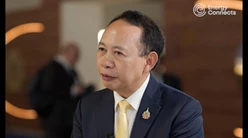Six Ways the COP30 Climate Summit Can Succeed or Fail
(Bloomberg) -- When Brazil was named host of the COP30 climate summit two years ago, it was seen as the perfect celebration of the 10th anniversary of the Paris Agreement, where nations pledged to keep climate change within safe limits.
In a month’s time, nearly 200 countries will gather at the gates of the Amazon rainforest for a new round of United Nations-sponsored climate talks. But there is still intense discussion about what the main outcome ought to be.
Unlike its past two editions, COP30 (officially, the 30th Conference of the Parties) doesn’t have a big headline deliverable. At COP29 in Azerbaijan last year, countries had to agree on a new global climate finance goal. The year before, negotiators took stock of climate progress and agreed for the first time to transition away from fossil fuels.

Brazil has said it wants to move from negotiation to implementation of goals. Yet that’s far from simple at a time when the US is withdrawing from the Paris Agreement, there are wars in Ukraine and Gaza and the world is less focused on climate action.
Success or failure will be the defining climate legacy of President Luiz Inácio Lula da Silva.
Here are some of the results that negotiators hope for in the Brazilian city of Belém next month:
NDC 3.0
Arguably the biggest deliverable of COP30 actually comes before the summit itself. Countries were required to submit their third round of climate pledges under the Paris accord — known as Nationally Determined Contributions — by the end of last month. These detail how much they plan to cut emissions by 2035 and the policies that will get them there.
More than half of the parties to the Paris Agreement, including China, have submitted their new NDCs. Yet many big emitters haven’t. The EU, the most climate-ambitious region, missed the deadline and so did India. The US submitted its pledge early, under the Biden administration, but President Donald Trump has scrapped many of the policies needed to meet it.
By the end of this month, the UN will tally all those emissions-cutting promises and compile a synthesis report showing just how far away the world is from the Paris target of limiting warming to 1.5C. Few expect the UN’s global warming projection to be much below 2.5C, which means countries are still way off course.
Mind the gap
Speak to veteran climate diplomats and they’ll tell you that this summit most closely resembles COP26 in Glasgow, UK — the last time countries were required to submit climate pledges, after a pandemic-related delay. That COP also didn’t have a mandated headline outcome, but it still delivered a landmark commitment to “phase down” unabated coal combustion, alongside a whole host of side deals that ranged from curbing deforestation to launching an alliance of climate-committed banks.

How Brazil responds to this year’s NDC synthesis will be the key barometer for success. Ambitious countries, like those in the EU, want to directly address closing the temperature gap to 1.5C and further solidify existing commitments like transitioning away from fossil fuels. But traditional blockers of more climate action, like Saudi Arabia, may well see the current geopolitical environment as an opportunity to walk back from some of those promises.
“What is lacking is political will,” said Tina Stege, climate envoy for the the Marshall Islands. “We need mitigation commitments delivered.”
After months of resistance, Brazil is beginning to warm to the idea of negotiating a so-called cover decision to address the temperature gap, according to people familiar with the matter. But there is little clarity so far over what will be included.
Finance roadmap
Last year, developed countries promised to deliver $300 billion in climate finance to developing nations and small island states by 2035. They also agreed to scale that by an extra trillion dollars through private sources, but left it vague as to how that would be achieved.
Some of those answers should be revealed at COP30. Brazil and last year’s Azerbaijani COP presidency are working on a “Baku to Belem” roadmap that activists hope will provide some concrete proposals to mobilize the significant amounts of money needed to help poor countries transition to clean energy and protect their economies from climate change.
Some possible options that have been floated include so-called solidarity levies on stock and bond trades, fossil-fuel emissions and first-class airfares. Yet many of those would need to be agreed outside of the COP process. Multilateral banks are seen as playing a key role, but many are now having to contend with a Trump administration that’s hostile to climate change.
The roadmap also won’t be negotiated, so it’s not clear how far it can go. What is for sure is that developing countries will be looking for more than just empty words.
Adaptation goal
The slow rate of progress in cutting emissions means that more attention is being paid to how countries, businesses and communities will adapt to climate change. For those on the frontlines of extreme weather, adaptation will be the key focus of this year’s summit.
Negotiators are unlikely to agree on a new, dedicated finance goal for adaptation, but they will need to narrow down a list of indicators that track resilience to climate change from 400 to about 100 by the end of COP30.
Side deals
Recent COP summits have come with myriad eye-catching declarations and initiatives. Critics say these serve as a useful distraction from the slow progress in negotiating rooms, and often get ignored as soon as everyone leaves. But they can also bring innovative new ideas to the fore and mobilize coalitions of countries to work together on issues like scaling renewable energy or improving farming techniques.
This year is unlikely to be different. One of the signature proposals is a $125 billion Tropical Forests Forever Facility, which will harness capital markets to pay countries to keep their woodlands standing. Another key side deal to look out for is a global coalition on carbon markets. That could bring diverse countries together to align how they put a price on carbon.
Brazil has also made the principle “Just Transition” a key pillar of COP30, to make sure that poor countries and communities aren’t left behind during the shift to a clean economy.
Keeping multilateralism alive
Ultimately, one of the main markers of success for COP30 could be proving that the diplomacy show is still on the road after the US, the world’s largest economy and biggest historical emitter of CO2, abandons the process.
Harjeet Singh, a longtime COP participant and founding director of the Satat Sampada Climate Foundation, said one “beacon of hope” emerged earlier this year, when the International Court of Justice said countries have a responsibility to do what they can to limit global warming to the critical threshold of 1.5C.
Even so, he said, geopolitics is casting an “ominous shadow” over the prospects for meaningful multilateralism. “This will be a long and arduous fight,” said Singh, “to protect our planet and its people against the forces of inertia and self-interest.”
©2025 Bloomberg L.P.





